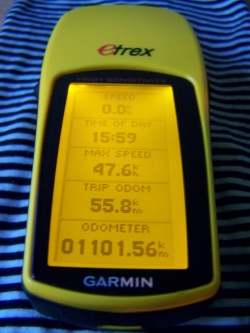If you wish to contribute or participate in the discussions about articles you are invited to contact the Editor
Outdoor Navigation
| Applications | |
|---|---|
| Title | Outdoor Navigation |
| Author(s) | Rui Barradas Pereira. |
| Level | Basic |
| Year of Publication | 2011 |
Outdoor Navigation consists in the navigation in outdoor environments such as nature trails. Outdoor Navigation is used mainly by outdoor enthusiasts (such as hikers, backpackers, geocaching enthusiasts, mountaineers or bikers) and outdoor workers (such emergency workers, wildlife preservation workers, forestry workers, farmers or mining workers)[1].
Outdoor Navigation is somewhat different from Pedestrian Navigation or Road Navigation since it uses the concepts of trails and waypoints instead of a turn by turn navigation. Maps are not always required since individual trails can be loaded on the device or trails can be created from hikes. When present, maps are very different from the ones used in Pedestrian Navigation or Road Navigation; outdoor navigation maps more closely related with topographic charts and military charts, rather than being street and road oriented.
Application Architecture
Outdoor Navigation is normally done using a custom Handheld Outdoor Receivers although standalone applications running on a mobile device can also be used. Handheld Outdoor Receivers are preferred by "heavy users" since these devices are normally ruggedized devices to endure an outdoor environment. For the occasional users there are applications that can run on GNSS-enabled phones with multimedia capabilities.
These applications normally work in a totally offline mode, since cellular coverage is usually unavailable in the places where Outdoor Navigation applications are to be used. Outdoor Navigation can be done without embedded map support although most devices support terrain maps with elevation information.
These applications have normally the following concepts[2]:
- Waypoint: Point with coordinates. The user can mark waypoints in the device and can select the waypoint to go to.
- Track: List of sequential waypoints that lead the user from the initial waypoint to the last waypoint through the trail.
- Waypoint Navigation: The device leads the user through the trail by leading him from the last waypoint reached to the next one on the trail.
- Track Log Recording: The trail taken by the user is stored in the device as a successive list of waypoints. This keeps a record of the trail done that can be later downloaded and can be used to return back in the trail.
- Return Back: The track log is reversed and the user is lead back to the starting point of the trail.
- Compass: These devices can be used as digital compasses. Some have an electronic compass that can be integrated with the GNSS positioning information.
- Altimeter: These devices can be used as digital altimeters. Some have a barometric altimeter that can be integrated with the GNSS positioning information.
These applications are considered as non-critical applications, although they can be used on emergency situations.
The accuracy required by these applications is low. The current accuracy provided by civilian GPS is enough for these applications. Availability, however, can be reduced by heavy foliage and deep canyons in this type of environment.
Application Characterization
Outdoor Navigation was one of the first personal uses of GNSS and the first consumer handheld GNSS receivers were intended for outdoor use. Normally, these devices are waterproof or at least ruggedized. An additional design driver is a low power consumption using regular batteries to endure continuous use during hours.
Geocaching is normally done using the same devices and applications used for generic Outdoor Navigation.
From a technical perspective outdoor navigation is one of the most simple navigation uses of GNSS. The receiver simply points a straight line towards the next waypoint in the track (loaded or recorded by the user). No maps are required and the display can be a simple monochromatic screen to save battery. Currently there are some ongoing studies aiming of creating simple indications that may help the users to easily understand how to reach a given destination. Two examples of those studies are the Direction Codes and Location Codes.
Despite this, there are outdoor receivers with color touch screens and that support also turn by turn navigation with street and road maps.
Application Examples
There are numerous outdoor navigation applications available for different smartphones and every major consumer GNSS receiver brand has several Handheld Outdoor Receivers in their portfolio.
Notes

